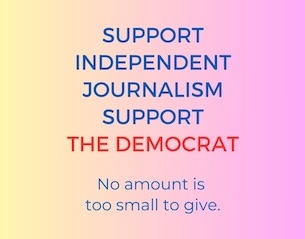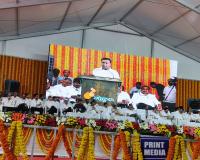- More
- Interview | Print media is more objective and balanced - Prof. Ujjwal Anu Chowdhury
Interview | Print media is more objective and balanced - Prof. Ujjwal Anu Chowdhury

What is your assessment of the media scenario in the country today?
If you look at the entire media and entertainment scenario, the industry is doing well, having crossed Rs 2 trillion (approximately $ 25 billion) in 2022 itself. It is expected to be close to $100 billion by 2030 at the current rate of year-on-year growth of nearly 20%. The digital media is booming, events at a high growth rate, and even entertainment has double digit growth rate. However, print media is static, television news growth is in single digits, radio news has not taken off due to the lack of government policy. People working in all types of media have crossed 3 million, with a high attrition rate as well due to technology and market challenges. While media as an industry has grown in revenue, their standards have visibly fallen.
Press is said to be the Fourth Pillar of Democracy. Is the Press in India upholding the basic tenets of democracy?
Unfortunately, newsmedia in recent times, especially the print and the electronic media, have by and large submitted to the ruling dispensation, with their watchdog role becoming largely that of a lapdog. Recalcitrant media houses have been browbeaten, lured, cases filed, or shareholding changed to alter ownership. Several ex- amples are there: NDTV, Wire, Newsclick, Dainik Bhaskar, etc. News media in India played a stellar role during the Emergency of the Indira government, even publishing blank editorials on the day Emergency was declared (by Indian Express and The Hindu). Increasingly debate and polemics are van- ishing from the Indian news media horizon.
How do you view the increasing corporatization of the media in India?
Corporatization is wel- come to bring in standard operating processes, transparency, recognition by merit, sourcing legitimate funds, timely payments etc. However, corporatization has also brought in a change from a Mission mindset to a Profession mindset, and now moving to a quick profit mindset. The role of the editor has been reduced. Sanctity of news content is being compromised, and business de- cisions dictate editorial choices increasingly.
Is the press in India free to play an objective role in an even playing ground?
Objective role has been compromised. The neutral role was always a chimera. No harm in news media having their own perspectives. But it must work in people’s interests. In case of the three farm bills, Indian media by and large toed the government line first. When the government withdrew the laws, the media was first perplexed and then started to tell how bad were those very laws which they were cheering all along! The dominance of Hindu-Muslim issues in the Indian media, especially the
electronic one, is at the cost of people’s issues of unem- ployment, education, health, security, etc. Lifestyle cover- age is replacing lifeline is- sues. Development journal- ism has taken a backseat. Dumbing down of news in times of speed and scattered attention of the audiences is a reality today across all plat- forms of news media.
How do you assess the content and coverage of the TV channels in the country?
The style of electronic media coverage is increasing- ly events and personalities centric. Media has forgotten to ask questions to those in power at various levels. Find- ing an adversary in every is- sue and taking the audience’s consciousness towards bash- ing the adversary and gain- ing a vicarious pleasure out of the visuality of all this, has become the goal of electron- ic media. Research is the last priority on television today. While the moment is cov- ered, the causes are hardly searched, the possibilities ahead are rarely told.
Similarly, is the print media still being able to maintain its traditional bal- anced and objective role?
The print media is more objective and balanced than the electronic media while there is a barrage of fake con- tent masquerading as news in the digital media. There are several newspapers managing to put up a brave front in India. However, the pressures of market economy, escalating costs and diktat of the regime are all ris- ing for them too. Print media reported on the migrant crisis and flawed farm laws critically to a large extent, including widespread deaths during the pandemic, all of which were under-reported in electronic media for sure.
The print media is said to be losing ground in the country. Your take on the issue?
The print media business has grown by merely 1% in the last two years, as per FICCI Frames reports. A large number of people in the print have lost their jobs. What is irrevocably seen is the integration of the newsrooms, that is coming of the print, the digital and the electronic together under the same room, manned by multi-skilled reporters and editors. The future moves toward news media convergence. The journalists of today and tomorrow have to quickly upskill themselves to procure, edit and package the same news item for the digital, the electronic, and the print media. Digital is immediate, electronic is visual and on the spot, print is analytical and well researched before publishing.
How do you assess the role of social media vis a vis the broadcast and print media?
Breaking news on the social media has actually added a major dimension to news today. Many celebrities and even politicians, including the Indian Prime Minister, first break stories on Twitter. Also, snacking of longer stories, investigations etc first in the social media, as a teaser, has become the norm today. However, more care and caution are needed for online news pursuing pace more than accuracy.
How do you view the scope and prospects of journalism as a profession?
Journalism as a profession will always remain an attractive proposition for those who are passionate about meeting people, observing phenomenal events, and interpreting happenings. Storytelling being multimedia today, it is now even more attractive. The returns for the mass journalists at the grassroots are low indeed. Investigation is short charged. For better prospects, today’s news media professionals have to be convergent, multimedia, multiskilled, at ease with broadcast and digital technologies, along with having a flair for writing, analysing and speaking on air. This is apart from being keenly interested in life in general and in one domain in particular (like politics, business, entertainment, development, crime, sports, etc).
000











